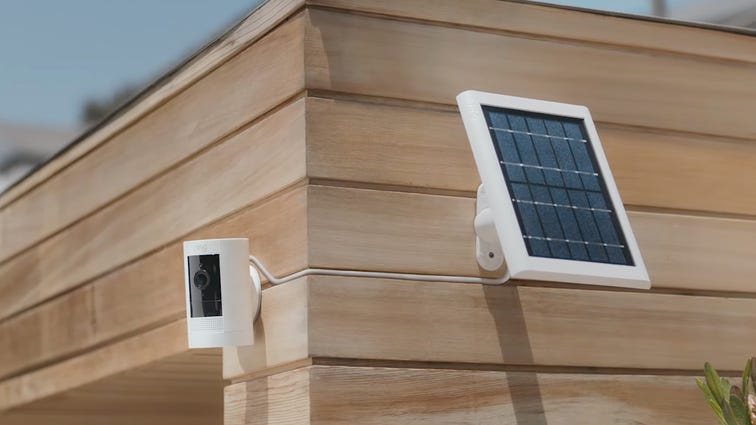Outdoor security cameras can be a huge time-saver when it comes to monitoring outbuildings, larger properties or simply the various entryways into your house. These cameras come in many varieties, with sirens, floodlights and plenty of other perks. But one of the biggest challenges is power: If the camera isn’t near an outlet — and outdoors it often isn’t — does that mean you have the hassle of changing batteries every few months?
Not if you use solar panels to power the camera. Solar-powered security cameras can mean a lot more practicality for outdoor cams that otherwise require complicated hardwiring (as anyone who’s tried to discreetly conceal wires behind siding knows) or frequent battery changes. But not every camera includes solar panels. In fact, our favorite outdoor security cameras — especially those from major brands — are frequently sold separately from panels, even if they are compatible with them.
While we’re still in the process of testing specialized solar-powered cameras, we have tested a wide variety of cameras that can optionally be used with solar panels. These are our favorite outdoor cams that work with solar panels.
Read more: Home security buying guide

 \n ","topic":"","ttag":"","variant":"","viewguid":"","event":"listicle|image|1","correlationId":"","_destCat":"https:\/\/www.amazon.com\/Arlo-Pro-Spotlight-Camera-Wire-Free\/dp\/B08L746NXW?th=1","productName":"Arlo Pro 4 (Black, 1 Camera)","formatType":"IMAGE","location":"LIST","position":1,"sku":"VMC4050B-100NAS","dwLinkTag":"article-body|listicle|image","selector":"#article-body #listicle-2c0ce801-9935-4e3f-8264-296c76bf98ac .itemImage"}}” rel=”noopener nofollow” target=”_blank”>
\n ","topic":"","ttag":"","variant":"","viewguid":"","event":"listicle|image|1","correlationId":"","_destCat":"https:\/\/www.amazon.com\/Arlo-Pro-Spotlight-Camera-Wire-Free\/dp\/B08L746NXW?th=1","productName":"Arlo Pro 4 (Black, 1 Camera)","formatType":"IMAGE","location":"LIST","position":1,"sku":"VMC4050B-100NAS","dwLinkTag":"article-body|listicle|image","selector":"#article-body #listicle-2c0ce801-9935-4e3f-8264-296c76bf98ac .itemImage"}}” rel=”noopener nofollow” target=”_blank”>


Arlo
Arlo’s $200 Pro 4 camera is a little pricier than some of the competition, but it’s a fantastic all-around device, boasting 2K resolution, a 160-degree field of view, two-way talk, a loud siren, a reliable spotlight, night vision and a load of other smarts. Unlike some other cameras, like the Arlo Pro 3 or Wyze’s solar-powered outdoor cam, you don’t need a base station to use the Pro 4.
To use the camera with a solar panel, you’ll have to buy the panel separately, which will set you back another $60. That makes this package a little pricier than some alternatives, but the quality of the device justifies that price tag.

 \n ","topic":"","ttag":"","variant":"","viewguid":"","event":"listicle|image|2","correlationId":"","_destCat":"https:\/\/www.amazon.com\/All-new-Ring-Stick-Up-Cam-Solar-HD-security-camera-with-two-way-talk-Works-with-Alexa-\/dp\/B07W7G23ZG","productName":"Ring Stick Up Cam","formatType":"IMAGE","location":"LIST","position":2,"sku":"88SC000FC100","dwLinkTag":"article-body|listicle|image","selector":"#article-body #listicle-626a290d-a10c-43b2-b3c2-28b714c9bad6 .itemImage"}}” rel=”noopener nofollow” target=”_blank”>
\n ","topic":"","ttag":"","variant":"","viewguid":"","event":"listicle|image|2","correlationId":"","_destCat":"https:\/\/www.amazon.com\/All-new-Ring-Stick-Up-Cam-Solar-HD-security-camera-with-two-way-talk-Works-with-Alexa-\/dp\/B07W7G23ZG","productName":"Ring Stick Up Cam","formatType":"IMAGE","location":"LIST","position":2,"sku":"88SC000FC100","dwLinkTag":"article-body|listicle|image","selector":"#article-body #listicle-626a290d-a10c-43b2-b3c2-28b714c9bad6 .itemImage"}}” rel=”noopener nofollow” target=”_blank”>


Ring
Ring sells a solid spotlight cam with its solar panel for $220, but if you want the best deal from the developer, you can get a Stick Up Cam with a solar panel for $149. That’s not bad, especially given the $100 cam’s relatively solid specs: 1080p resolution, night vision, two-way talk, 115-degree field of view, built-in siren and other smarts.
If you’re looking for a good deal, you can also find this package for even lower prices fairly frequently — especially during parent company Amazon’s Prime Day sale.
Solar-powered security camera FAQs
Are solar-powered cameras any good?
Short answer: It all depends on where you live. To get the most out of solar panels, you need to angle them toward the equator, and tilt them according to your latitude. In regions farther to the global north or south, you’ll likely generate less power than in regions closer to the equator. Likewise, the power generated will correspond to the season and weather. In other words, a cloudy week in Alaska during December isn’t going to give your solar panels as much to work with as a sunny week in Florida during July.
That said, solar-powered security cameras generally use batteries to store the power generated during the day, so a few cloudy days probably aren’t going to mean a cut feed. In short, they’re not foolproof, but depending on your region, solar panels can seriously lengthen the battery life of your outdoor cameras — or even do away with regular battery replacements altogether.
How long do solar-powered security cameras last?
Much of this comes down to region once again, but assuming you live in a good area for solar power — and you keep your panel properly angled and clean — many people report exceedingly rare battery replacements.
Do solar-powered security cameras work at night?
Solar-powered security cameras will work during the night using the battery power stored up during the daytime. Remember: Both of the cameras above have built-in batteries that normally last months. That means you shouldn’t run into issues with overnight battery drainage — and if you do, it’s probably a problem with the battery, not the solar panel.
How we test
Home security cameras are tricky devices to test, because how good they are doesn’t just come down to how their numbers stack up against the competition’s. We do look for better resolution, wider field of view and the presence of must-have features in 2022, like two-way talk, night vision and options for cloud storage. Then we add in extra goodies, like smart notifications or a built-in siren or spotlight, and hold up that whole package against its retail price. If the features are really strong for the price, we’ll recommend a camera more highly.
But we also test our cameras carefully, making sure all the features work well. Smart notifications aren’t helpful if they arrive 20 seconds late; a siren isn’t useful if it’s barely audible. And not all user experiences are equal: Some cameras suffer from disconnection, and some apps are difficult to understand or navigate. This experiential side of things is where our recommendations become more personal and in many ways more useful. Anyone can line up the specs of different products, but we’re putting our hands on them for a week or more to see how it actually feels to install and use them.
In the case of solar-powered home security cameras, we’ve tested each of these devices extensively — but not necessarily with their solar panels. We hope to fill out this article in the coming months, adding more cams with built-in solar panels and testing the performance of the solar panels themselves on a more granular level, so be sure to check back often to see more recommendations.


